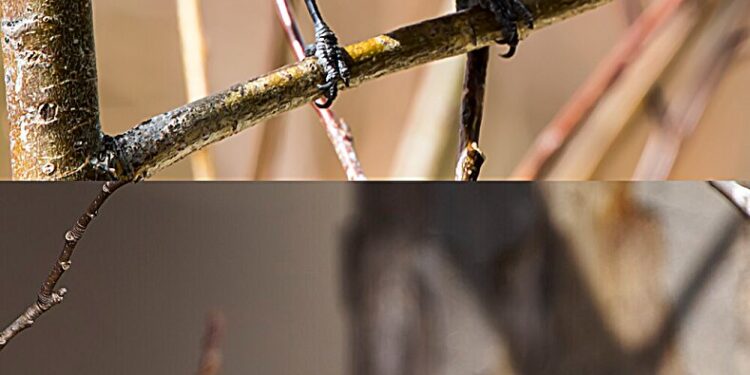Boulder’s mountain chickadees have evolved a different tone to avoid being confused with their cousins, according to a new study led by CU Boulder and published Oct. 9 in the Journal of Evolutionary Biology.
The results provide real-time evidence for one of Charles Darwin’s famous theories and shed light on the impact of pressure from human activity on the evolution of wildlife.
Mountain chickadees, common in the high-elevation coniferous forests of the west coast of North America and in the Rocky Mountains, are noisy animals. They constantly whistle a chirpy “bee-bee-bee-bee” song to attract mates or defend their territories.
Black-capped chickadees are their close relatives. The two birds look very similar, except that mountain chickadees have a pair of white eyebrow-like stripes above their eyes. Black-capped chickadees tend to live at lower elevations, and in some areas, such as Colorado’s Boulder County, the habitats of the two birds overlap.
Scott Taylor, one of the paper’s lead authors and an associate professor in the Department of Ecology and Evolutionary Biology, wondered whether this unique lifestyle would cause chickadees to develop different traits. His team’s hypothesis is based on Darwin’s “character displacement” theory, which suggests that closely related species with overlapping habitats tend to diverge in terms of traits, such as appearance and call, to reduce competition or costly hybridization between different species.
Galapagos finches are a classic example. These closely related birds of the Galapagos Islands have evolved different beak shapes and sizes from each other to specialize in eating different types of seeds, thereby reducing competition.
In Boulder, where two species of chickadees coexist, researchers wondered if the birds had started humming a different tune.
“In birds, song is an important characteristic for individuals to recognize each other,” said Olivia Taylor, first author of the paper and recent graduate of the Department of Ecology and Evolutionary Biology.
To explore this, the team collaborated with researchers from the University of Western Ontario and Cornell University, who recorded more than 2,000 chickadee songs. They sampled black-capped and mountain chickadees in Boulder, where the two species coexist. They also tracked populations of mountain chickadees in California and black-capped chickadees in New York, where each species lives alone.
They discovered that chickadees in the Boulder Mountains sing differently than those in California. Instead of the common four-note “bee-bee-bee-bee” song, Boulder Mountain Chickadees whistle with more notes. For example, many of their songs are five to six notes long, which is significantly longer than the two-note songs of black-capped chickadees living in the same region.
Boulder mountain chickadees are also more likely to include one or two introductory notes (short chirps at the beginning of a song) compared to California mountain chickadees and their black-capped cousins.
“Our ears couldn’t really pick up these longer introductory notes, and we only noticed it after recording and analyzing the songs. But birds’ hearing is much better than ours, so they certainly can distinguish them,” Scott said. Taylor, who led the Boulder Chickadee Study at the CU Boulder Mountain Research Station for six years.
Previous research shows that black-capped chickadees dominate mountain chickadees when they coexist. Black-capped Chickadees often chase away Black-capped Chickadees if they get too close, and Black-capped Chickadees usually wait until Black-capped Chickadees have finished eating and leave before approaching feeders.
Although both species can reproduce, female hybrid offspring produced from a black-capped chickadee and a mountain chickadee are likely sterile.
Singing a different song may help mountain titmice distinguish between friends and foes and avoid interbreeding, the authors said.
“There is a reproductive cost to hybridizing with each other. From an evolutionary perspective, sterile females are a dead end in reproduction. And perhaps hybrid males also suffer physiological costs that we don’t know about “However, because the two species are adapted to different altitudes, some hybrids may have difficulty surviving cold winters in the high mountains,” said Scott Taylor.
A few hundred years ago, mountain chickadees inhabited Boulder’s coniferous forests, alongside probably far fewer black-capped chickadees than today. As settlers moved in and planted ash and maple trees, they also created excellent habitats for black-capped chickadees. As a result, the black-capped population is likely much larger now and the birds interact more frequently with local mountain titmice.
“It’s very interesting to see how these species respond to what is ultimately human-introduced pressure,” Olivia Taylor said. “For this, I think it is important to document and understand our impacts on wildlife and how they adapt to coexist.”
More information:
Olivia Taylor et al, Chickadees sing different songs in sympatry versus allopatry, Journal of Evolutionary Biology (2024). DOI: 10.1093/jeb/voae114
Provided by University of Colorado Boulder
Quote: Mountain titmouse songs provide real-time evidence for Darwin’s character displacement theory (October 11, 2024) retrieved October 11, 2024 from
This document is subject to copyright. Except for fair use for private study or research purposes, no part may be reproduced without written permission. The content is provided for informational purposes only.



